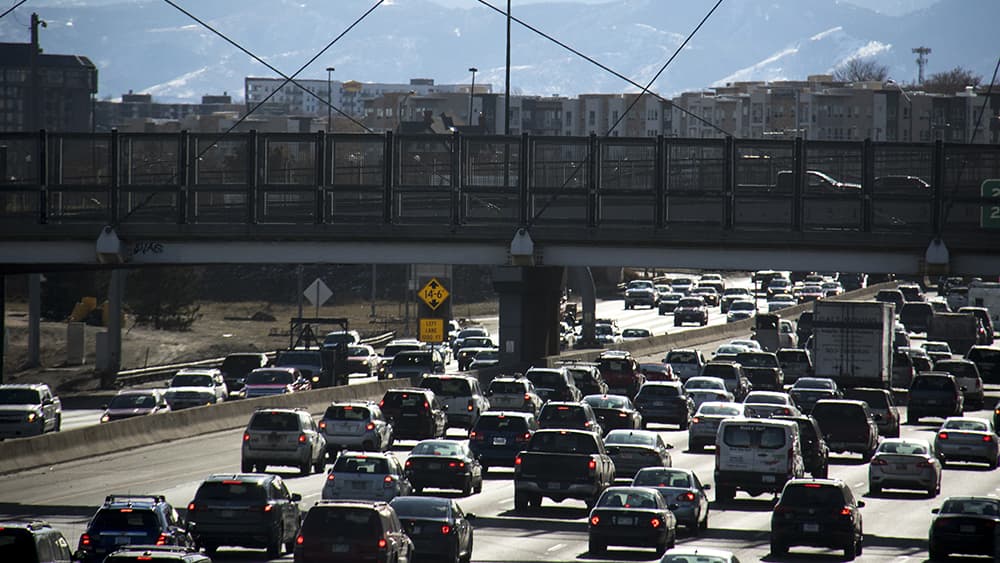As the Colorado Department of Transportation starts a controversial widening of I-70 through minority, low-income neighborhoods in north Denver, it is planning changes to the city's other interstate, I-25, to prepare for more growth and reduce crashes.
CDOT is mulling several options for the six-mile stretch between Santa Fe Drive and 20th Street in the heart of the city. "I-25 Central" carries about 250,000 vehicles per day, according to CDOT.
Adding a multi-lane deck atop the current freeway is on the extreme end of a spectrum of possibilities that includes widening the interstate, tolling it, realigning it, adding light rail tracks, building raised on and off ramps, and building more feeder roads. Replacing the highway with an urban boulevard has already been scrapped.
Also on the table: Congestion pricing, or charging drivers to use the highway during rush hours to steer people toward transit and encourage driving at different times. New York is the only American city to try this tact after a years-long political fight.
"My gut instinct is we need to use a lot of these options all at once," CDOT engineer Chris Enright Enright said at a Thursday public meeting. "There's no way we can do this without operations and demand management and without helping transit."
Basically, the transportation department will put a whole bunch of factors into a computer -- population growth, travel behavior, demand induced by more roads -- that will decide which changes will move more people more efficiently and safely.
CDOT should have more solid answers in July, and will whittle options down further in October, Enright said. A department spokesperson could not provide a date range for construction.
Ramp changes could curb crashes, Enright says, which average about three per day. Drivers entering and exiting the highway with short runways cause both crashes and congestion.
CDOT chief Shoshana Lew has signaled a different route for the transportation agency since Governor Jared Polis appointed her -- one that veers away from highway expansions that make more room for cars, and steers toward moving people differently.
The 2005 widening of I-25 -- even with the addition of light rail -- resulted in more traffic congestion than ever less than five years later, according to a report by the Southwestern Energy Efficiency Project.
"If they build it, they will come," said Travis Madsen, SWEEP's transportation program director. "If you make more space on the highway, people will think that's the best way to get from point A to point B and fill it up with cars."
Transit, incentives and disincentives, like congestion pricing, are better options than expansion, he said.
Some of CDOT's current options point to expansion anyway. But there's a problem: There's no room.
The river and railroad tracks hem the highway in. Rerouting the highway is one possibility, but it's a major project that requires cooperation from Union Pacific and the Burlington Northern Santa Fe Railway. And the city itself doesn't have space for endlessly more cars, hence its Denveright plans to get people out of them.
So transit could play a major role in an I-25 makeover, according to Lee Cryer, a project manager with the Regional Transportation District who works with CDOT on the $3 million study. In 2040, better transit options could steal up to 13,500 trips per day from I-25, according to RTD projections.
If a realignment happens, CDOT and RTD would likely add two RTD tracks (four total) to relieve bottlenecks on the agency's C, D, E, F, H and W light rail lines. There's also talk of light rail or bus rapid transit lines running down Federal Boulevard, Broadway and Lincoln to shift downtown car commuters to transit.
"We're definitely interested in beefing up our capacity," Cryer said.
Any talk of widening highways in Denver evokes the fight against I-70.
Urban highways are a symbol of environmental injustice in cities across America. State and federal transportation departments often routed them through low-income, minority neighborhoods in the 50s and 60s to avoid strong pushback, and neighborhoods today still deal with their legacy.
CDOT experienced years-long pushback when it wanted to widen I-70 through Elyria and Swansea. The department succeeded, and though it cut checks to residents, many were displaced. Some activists are skeptical.
"I guess I'm enthused that CDOT is at least trying to have a conversation in advance about it but it still feels like its coming from the same place, where you just check the box of community engagement," said Brad Evans, who was one of several leaders opposing the project.
He said he will pivot his influential Facebook group, "Ditch the Ditch," from the I-70 conversation to an "education conversation" about I-25.













